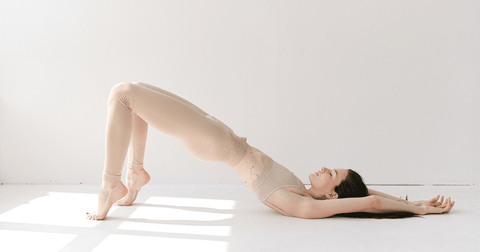Now that it’s officially mainstream, some people are hoping to use CBD for period cramps instead of over-the-counter painkillers because it has fewer side effects and it’s all natural.
When it comes to cramp relief, however, natural is nice, but it has to work—especially if you’re among the 1 in 3 women who endure severe pain every cycle [1]. It feels as though CBD is touted as a cure-all for any ailment; is using it for period pain just part of the hype, or the solution you’ve been waiting for?
This article explores whether CBD can deliver the kind of efficacy needed to provide real cramp relief, according to our best science.
- Unlike other natural cramp remedies with mounting clinical evidence, no studies have shown that CBD relieves period cramps.
- Preliminary research shows CBD offers promising relief from chronic pain, especially pain relating to the nervous system. However, period pain is a different type of pain, and menstrual cramps aren’t among the conditions CBD’s been shown to address.
- If you’re searching for natural cramp relief that actually works, we can empathize. Our founder tried everything to manage her brutal cramps, but no option was both safe *and* effective. We created Cramp Aid to be the fast-acting, non-drug solution to period pain that so many women desperately need.
Does CBD help with menstrual cramps?
Because there isn’t clinical evidence to support using CBD for period cramps, the answer (for now) falls somewhere between ‘maybe’ and ‘no’.
CBD may offer other benefits besides cramp relief that can help make periods easier (these are discussed below). But currently, CBD is not recommended for period cramps because no studies have evaluated its effect on menstrual pain in real women.
Unlike other natural remedies that have been researched for many decades or centuries, almost everything scientists understand about CBD and pain was discovered in the last 20-30 years [2]. While future research may reveal new insights, the present science on CBD for period cramps is far from solid, and has yet to address the issue of menstrual pain directly.
For example, according to some scientists, CBD may help relax blood vessels so blood and oxygen can flow to tissues more easily [2]—which would be good news for cramps. Constricted blood vessels in the uterus are actually one of the main drivers of period pain in the first place. However, those scientists admitted CBD also has blood vessel-constricting properties (which would make period cramps worse), and no one’s tested it on a cramping uterus.
Until there’s data showing CBD works for cramps in menstruating humans rather than petri dishes or lab rats, we prefer more evidence-based solutions like ginger, vitamin B1, and fenugreek. These ingredients have gone head-to-head with conventional painkillers for menstrual pain relief in clinical trials, and were shown to be just as effective [3, 4, 5]. We included each of them in Cramp Aid.

Then why does it feel like everyone from your yoga instructor to your grandma is using CBD for pain?
Pain is complex, and menstrual pain unique. Just because CBD works wonders for your grandma’s arthritis doesn’t mean it will do the same for your period cramps.
The science on CBD for pain
The research is promising for CBD as a natural pain-reliever, just not a period pain reliever.
CBD, or cannabidiol, is one of the 80 or so special compounds (known as cannabinoids) found in the Cannabis plant. The body responds to cannabinoids via the endocannabinoid system—a network of receptors throughout the body that interact with CBD to influence various processes, including pain perception [6].
Receptors in the brain are thought to play a role in CBD’s calming properties [7], whereas receptors on tissues elsewhere in the body are believed to be responsible for CBD’s role in pain and inflammation [8].
The emerging research shows promise for CBD in pain management—but not necessarily for all types of pain. According to clinical trials, cannabinoids may help reduce pain related to conditions like multiple sclerosis [9], fibromyalgia [10], rheumatoid arthritis [11], and HIV [12].
However, almost all research about cannabinoids and pain have studied the effects of CBD in combination with THC, rather than CBD alone [6]. These conditions also have something in common: they’re all examples of chronic pain, and most are examples of neuropathic pain—or pain due to a damaged nervous system [13].
Period pain is neither chronic nor neuropathic pain [14]. Period cramps originate in muscular tissue (uterine muscles, specifically)—not nervous tissue. And whereas chronic pain is constant, relentless, and the result of some unresolved (or unresolveable) disease or injury, menstrual pain is an example of acute pain, meaning it’s temporary.
Period cramps are often considered to be a chronic issue because they can significantly damage one’s quality of life, and because they reappear consistently throughout one’s reproductive years [15]. But unlike other instances of chronic pain, period cramps are part of the body’s natural response to inflammation.
Even the healthiest menstrual cycles involve some inflammatory processes at certain phases. To a certain degree, pro-inflammatory molecules are supposed to accumulate in your uterus before your period, because they help set menstrual bleeding in motion [16]. And because of their connection to your hormonal cycle, they reliably resolve themselves when your period ends.
We’ll note that not everyone’s menstrual cramps are acute; an important exception is period pain related to an underlying gynecological condition like endometriosis or adenomyosis, which are chronic conditions. But in the vast majority of cases, common menstrual cramps are functionally different from chronic pain.
There’s little evidence that CBD relieves acute pain. Experts say the available research is low quality, only indicates a small change in pain levels, and shows that CBD doesn’t work as well for pain when it’s taken orally compared to when it’s injected directly into the painful area [17]. Because the current science only supports using CBD for chronic pain relief [18], acute period cramps may require a different solution.

Possible benefits of CBD for menstrual health
Although the current research doesn’t support using CBD for period cramps, that doesn’t mean CBD is useless for periods.
Some scholars say practitioners in ancient China used the Cannabis plant to treat a variety of ailments, including menstrual symptoms [19]. And if you search various corners of the internet, you’ll likely find anecdotes of women swearing by CBD the week of their period.
It turns out there’s evidence to back these reports. Research shows CBD may be helpful for relieving anxiety and improving sleep quality—issues that commonly arise during the luteal phase of the menstrual cycle, when PMS strikes.
In one clinical trial, CBD reduced anxiety in nearly 80% of users, and improved sleep quality in about 66% of users within the first month of use [19]. Too little sleep is a common culprit behind hormonal imbalances in women, so using CBD to regulate your sleep cycle may help improve your overall hormonal health.
Natural cramp remedies with more clinical evidence than CBD
While the science on CBD is still evolving, the science of menstrual pain is well-established.
Thankfully researchers understand a lot about what causes period cramps, and why some remedies work and others don’t. If your goal is to find a natural period cramp remedy that actually works, you don’t need to wait for CBD to play scientific catch up to get the relief you deserve.
Unlike CBD, certain vitamins, minerals, and herbs have been widely used for menstrual cramps for centuries—and importantly, their historical use is backed by rigorous clinical studies in real menstruating women. Because for us, it’s evidence-based or bust.
We obsessed over the menstrual health research to identify the natural ingredients shown to relieve period pain and PMS in clinical trials. We chose the ones with the best evidence of safety and efficacy, and included them (in amounts that matter!) in our science-backed solutions: Cramp Aid for fast, use-as-needed period cramp relief, and Steady Mood for multi-symptom PMS relief and hormonal support. Shop them both in our Period Rescue Kit.

Courtney Mayszak, RDN, LDN, is the co-founder and Chief Product Officer at De Lune. She’s a Registered Dietitian Nutritionist who completed her bachelor’s degree and dietetics training at Cornell University. When she’s not poring over menstrual health research, find her educating about cycle health on Instagram @delunecare.
This information is for educational purposes only. It is not a substitute for professional medical advice, and is not intended to diagnose, treat, cure, or prevent any condition.
References
1. Söderman, L., Edlund, M., & Marions, L. (2019). Prevalence and impact of dysmenorrhea in Swedish adolescents. Acta obstetricia et gynecologica Scandinavica, 98(2), 215-221.
2. Stanley, C., & O'Sullivan, S. E. (2014). Vascular targets for cannabinoids: animal and human studies. British Journal of Pharmacology, 171(6), 1361-1378.
3. Ozgoli, G., Goli, M., & Moattar, F. (2009). Comparison of effects of ginger, mefenamic acid, and ibuprofen on pain in women with primary dysmenorrhea. The journal of alternative and complementary medicine, 15(2), 129-132.
4. Aghamohammady, A., & Tofighi, M. (2011). Comparing the effect of vitamin B1 (vit. B1) and ibuberofen on the treatment of primary dysmenorhea. African Journal of Pharmacy and Pharmacology, 5(7), 874-878.
5. Inanmdar, W. et al. (2016). Clinical efficacy of Trigonella foenum graecum (Fenugreek) and dry cupping therapy on intensity of pain in patients with primary dysmenorrhea. Chinese journal of integrative medicine, 1-8.
6. Fine, P. G., & Rosenfeld, M. J. (2013). The endocannabinoid system, cannabinoids, and pain. Rambam Maimonides medical journal, 4(4).
7. Glass, M., Faull, R. L. M., & Dragunow, M. (1997). Cannabinoid receptors in the human brain: a detailed anatomical and quantitative autoradiographic study in the fetal, neonatal and adult human brain. Neuroscience, 77(2), 299-318.
8. Beltramo, M. (2009). Cannabinoid type 2 receptor as a target for chronic-pain. Mini reviews in medicinal chemistry, 9(1), 11-25.
9. Wade, D. T. et al. (2006). Long-term use of a cannabis-based medicine in the treatment of spasticity and other symptoms in multiple sclerosis. Multiple Sclerosis Journal, 12(5), 639-645.
10. Boehnke, K. F. et al. (2021). Substituting Cannabidiol for Opioids and Pain Medications Among Individuals With Fibromyalgia: A Large Online Survey. The journal of pain.
11. Blake, D. R. et al. (2006). Preliminary assessment of the efficacy, tolerability and safety of a cannabis-based medicine (Sativex) in the treatment of pain caused by rheumatoid arthritis. Rheumatology, 45(1), 50-52.
12. Woolridge, E. et al. (2005). Cannabis use in HIV for pain and other medical symptoms. Journal of pain and symptom management, 29(4), 358-367.
13. https://my.clevelandclinic.org/health/diseases/15833-neuropathic-pain
14. Iacovides, S., Avidon, I., & Baker, F. C. (2015). What we know about primary dysmenorrhea today: a critical review. Human reproduction update, 21(6), 762-778.
15. Davis, A. R., & Westhoff, C. L. (2001). Primary dysmenorrhea in adolescent girls and treatment with oral contraceptives. Journal of pediatric and adolescent gynecology, 14(1), 3-8.
16. Lindner, H. R. et al. (1980). Significance of prostaglandins in the regulation of cyclic events in the ovary and uterus. Advances in prostaglandin and thromboxane research, 8, 1371-1390.
17. Gazendam, A. et al. (2020). Cannabinoids in the management of acute pain: a systematic review and meta-analysis. Cannabis and Cannabinoid Research, 5(4), 290-297.
18. Urits, I. et al. (2020). Use of cannabidiol (CBD) for the treatment of chronic pain. Best Practice & Research Clinical Anaesthesiology.
19. Shannon, S. et al. (2019). Cannabidiol in anxiety and sleep: a large case series. The Permanente Journal, 23.








